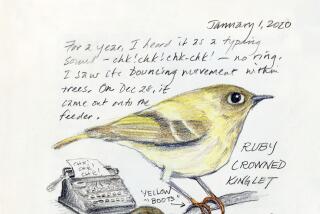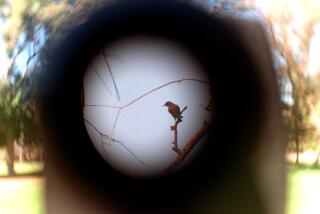William Wharton, 82, dies; Expressionist painter launched new career as novelist
William Wharton, an Expressionist painter who launched a new career as a novelist in his 50s and won an American Book Award for his first novel, “Birdy,” has died. He was 82.
Wharton, who had been in failing health for some time, died Wednesday at Scripps Memorial Hospital in Encinitas, north of San Diego, said his wife of 58 years, Rosemary.
The Philadelphia-born Wharton was 53 and making his living as an artist in Paris under his birth name, Albert du Aime, when “Birdy” was published by Knopf in 1979.
A highly original novel, “Birdy” opens in an Army hospital ward at the end of World War II. There, a young soldier who has been emotionally shattered by the horrors of combat retreats so much into the safer world of the birds he raised as a youth that he actually believes he is a bird. “Birdy” won the American Book Award for first novel and was a Pulitzer Prize runner-up for fiction.
“Only the most rigorous imagination can make a story of this sort work for a reader who is generally indifferent to birds,” wrote Newsweek magazine reviewer Peter S. Prescott. “Wharton has just such an imagination.”
Rosalie Siegel, Wharton’s agent since she sold “Birdy” to Knopf, said that when she first read the manuscript, “I thought it was an amazing novel with a very original voice. It just swept all of New York publishing off its feet initially and was a sensation upon publication.”
“Birdy,” which became a national bestseller, was made into a1984 film starring Nicolas Cage and Matthew Modine.
Two other Wharton novels also became movies: “Dad,” the story of three generations of the men in one family, and “A Midnight Clear,” a World War II story of a Christmastime encounter between a small group of Germans who would like to surrender to a squadron of GIs holed up in an abandoned chateau in the Ardennes Forest during the Battle of the Bulge.
Wharton was known for closely guarding his privacy, which is why he chose to use a pseudonym for his writing. (William Wharton is derived from his middle name and his mother’s maiden name.)
“My private life means a lot to me, and one of the best ways I could think of to protect [it] is to write under a pseudonym,” he told the Chicago Sun-Times in 1992.
Or, as he told the Fort Lauderdale Sun-Sentinel in 1995: “In France, I’m just a crazy painter who lives on a boat, but I didn’t want to become an American celebrity, even a small literary one.”
Wharton, who has said fantasy and intimacy were the two main aims of his writing, told the Times of London in 1986 that “one of the reasons I don’t want to live the life of a writer is I don’t want writers’ problems.
“Not thinking of myself as a writer gives me the freedom to be one. I’m not a wordsmith. I just basically look into my head and see the image and look for words.”
He was born Nov. 7, 1925, into what he later told London’s Guardian newspaper was “a very poor, hard-working, uneducated Catholic family.”
Wharton, who raised as many as 250 canaries while growing up, volunteered for the Army at age 17 during World War II. While serving in the 87th Infantry Division, he was severely wounded during the Battle of the Bulge.
After the war, he earned a degree in art from UCLA, where he received a doctorate in psychology in 1960. He taught art in Los Angeles city schools for 11 years before packing up and moving his family to Europe in 1960.
“When our oldest [child] got into the beginning of the television age, we decided we didn’t want our children growing up like that,” he said in a 1979 interview for the Biography Resource Center. “We felt a strong desire to get out of the pressure from the American competitive-comparative-consumer society.”
After moving around Spain, Italy, Germany and France, they settled in Paris in 1968, dividing their time between an apartment in the city and a houseboat in Port Marly on the Seine, about 10 miles away.
He wrote about it in his 1996 book “Houseboat on the Seine.”
Although he began writing novels in 1950 and wrote several over the years, he never attempted to get them published. It wasn’t until 1977 that a friend, urging him to submit his latest, “Birdy,” introduced him to the woman who became his agent.
Wharton continued to paint after achieving critical and financial success as an author. As a writer, he said, he was driven by a passion “to share, to communicate.”
That included sharing with readers the 1988 death of his daughter, Kate, and her husband and two young children in a 23-car highway crash in Oregon caused by heavy smoke from a grass-seed burning on a nearby farm.
His book “Ever After: A Father’s True Story” recounts his daughter’s life and death and his efforts to seek redress for her and her family’s deaths in court.
For the last seven years, Wharton and his wife had been spending winters in Solana Beach in San Diego County.
In addition to his wife, Wharton is survived by his sons, Matt and William du Aime; his daughter, Camille du Aime Russell; five grandchildren; and one great-grandson.
McLellan is a Times staff writer.
More to Read
Start your day right
Sign up for Essential California for the L.A. Times biggest news, features and recommendations in your inbox six days a week.
You may occasionally receive promotional content from the Los Angeles Times.






